NEWS
IPRC scientists promote preparation for impending Pacific Islands drought
Honolulu, December 31, 2015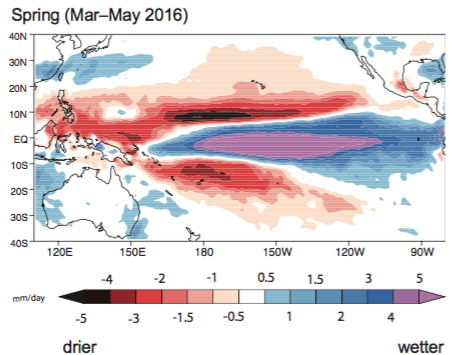
The El Niño of 2015-2016 is shaping up to be one of the strongest events since the phenomenon was recognized 60 years ago, predicted to bring heavy, flooding rains to the eastern Pacific, but excessive drought to the western Pacific basin. IPRC personnel, led by H. Annamalai, have investigated the effects on particularly vulnerable Pacific Islands, some of which are already feeling the results of the shifting weather: fresh water shortages, crop failures, depletion of fishing resources, heavier storm activity and increased risk in the spread of water- and insect-borne diseases. The authors present a number of strategies for short-term and long-term preparation and mitigation, as well as policy and educational resources. Read the full article to learn more about the team's suggestions.
IPRC Senior Researcher Dr. Tangdong Qu leaving
Honolulu, December 23, 2015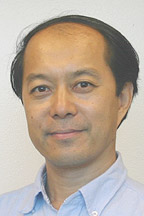
This month, we bid a regretful farewell to Dr. Tangdong Qu, a senior researcher who was among the founding members of the IPRC, and whose research contributions have been impressive. He has explored ocean climate processes, examining the effects of the dynamics of the upper ocean on the larger ocean heat budget, as well as pursuing the effects of climate change on ocean circulation, particularly on the currents of the western Pacific. Dr. Qu has been an important member of the IPRC ‘ohana and will be greatly missed. We wish him the best of luck in his future pursuits at the Joint Institute for Regional Earth System Science and Engineering at UCLA.
IPRC group shows rapidly acidifying waters pose major threat for Southern Ocean ecosystem
Honolulu, November 2, 2015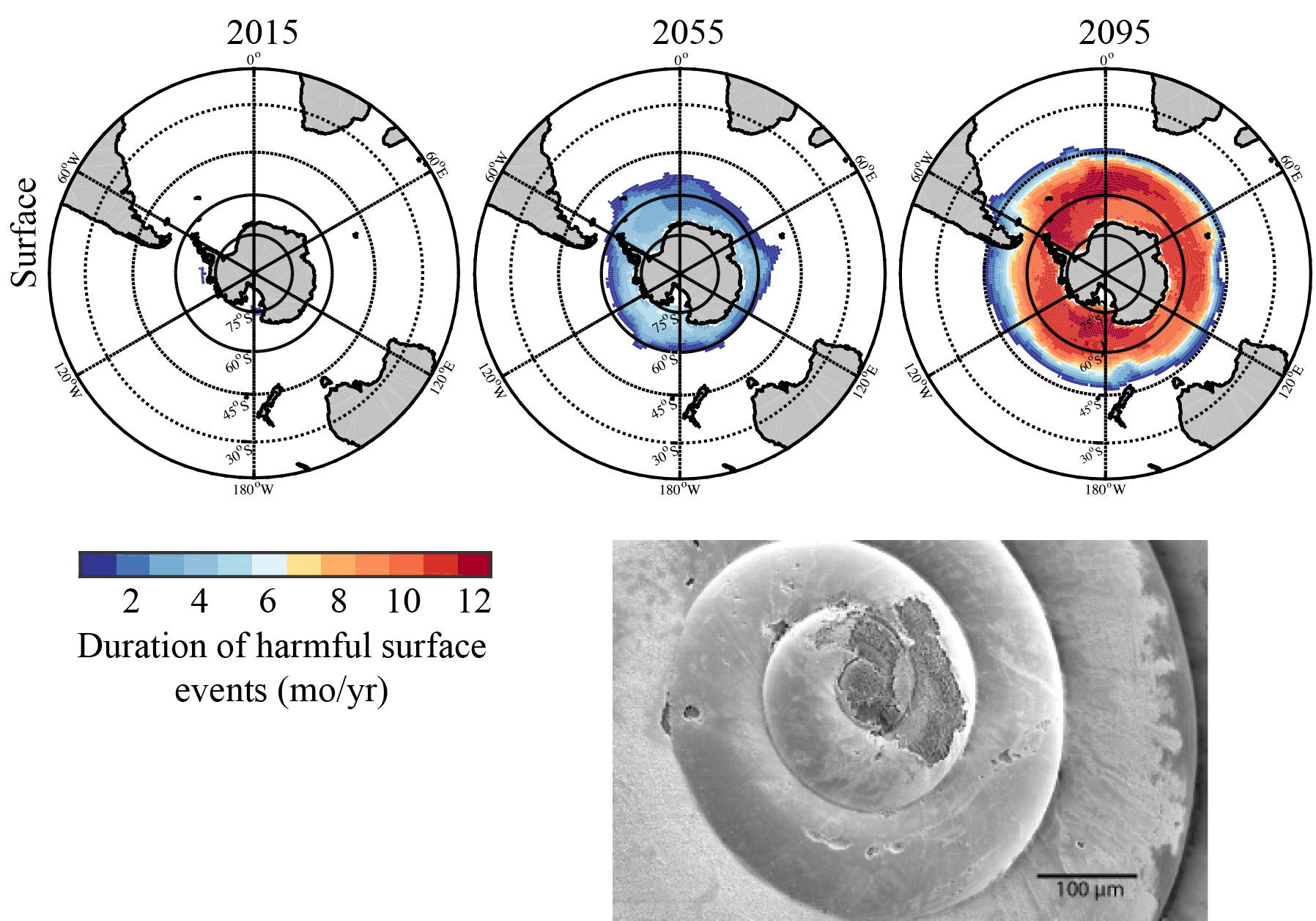
As a result of increasing atmospheric carbon dioxide concentrations, the chemistry of the Southern Ocean is expected to change so fast over the next few decades that small, but important, creatures at the base of the food web may soon struggle to form their carbonate shells. For some organisms the onset of such critical conditions will be so abrupt, and the duration of events so long, that adaption may become impossible, according to new research by Claudine Hauri, at both the International Arctic Research Center (IARC) at the University of Alaska, Fairbanks and the IPRC, in collaboration with Tobias Friedrich and Axel Timmermann of IPRC. Read more in the press release, or the original journal article, and view an explanatory video here. Visit an article here at The Age. Read the story at IARC and at the Ocean Acidification International Coordination Center (OA-ICC). Hear an interview with Axel Timmermann by Radio New Zealand. Hear a new interview with Claudine Hauri by Fairbank's Changing Arctic, and read a Q&A with Claudine at the Ocean Conservancy blog.
IPRC scientists reach out to science fans of all ages
Honolulu, October 29, 2015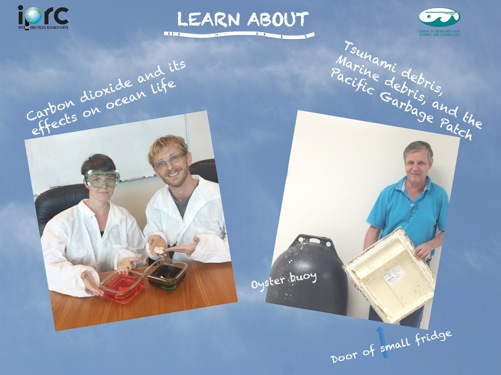
Last week saw the 13th biennial Open House for the School of Ocean and Earth Science and Technology (SOEST) at the University of Hawai‘i at Mānoa. Amongst the many presentations, demonstrations, and hands-on activities, several IPRC researchers contributed their own knowledge to the welter of information. Tobias Friedrich and Michelle Tigchelaar introduced students to the effects of carbon dioxide on the ocean and its coral reefs, while Jan Hafner provided an intriguing look at the movement of debris around the Pacific Ocean basin. Niklas Schneider helped run an ongoing demonstration of "Weather in a Tank", and Axel Timmermann provided a presentation about glacial events in Hawai‘i for the Speaker's Room. Read more.
New model by IPRC researchers explains near-annual Monsoon patterns generated by El Niño
Honolulu, October 19, 2015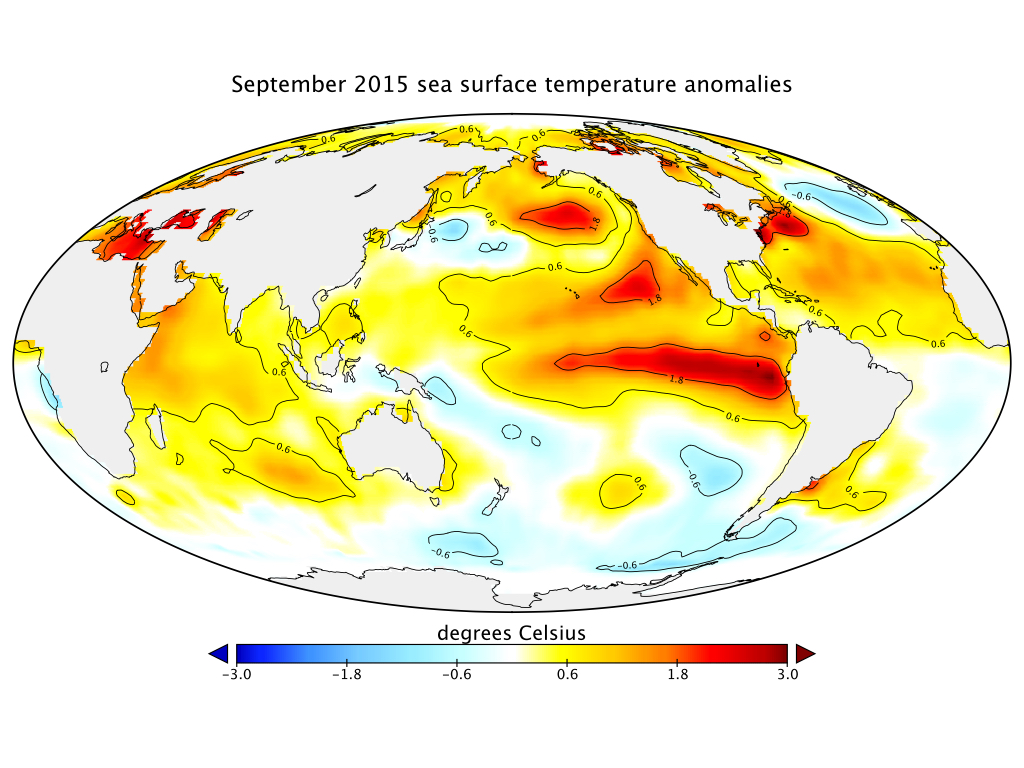
The El Niño Southern Oscillation (called ENSO) is one of the most prominent climate events on the globe. Every two to seven years, temperature shifts cause modifications in wind and rainfall patterns in the Pacific, triggering changes in the climate around the world. A new study by Malte Stuecker and Fei-Fei Jin from Department of Atmospheric Sciences in collaboration with Axel Timmermann from IPRC present a new methodology which explores how interaction of the El Niño phenomenon with the annual cycle of solar radiation in the western Pacific generates a suite of predictable wind and rainfall patterns associated with the Southeast Asian Monsoons. In contrast to the inter-annual timescales of El Niño, monsoon oscillations occur on nearly annual timescales. The methodology provides a new way to explore atmosphere variability, as well as a number of other climate phenomena. Read the press release for more details.
IPRC Welcomes New Outreach Specialist
Honolulu, October 9, 2015
IPRC welcomes Rachel Lentz as IPRC Outreach Specialist. Rachel comes to us with a background in teaching and science. She is eager to join IPRC in communicating to the world at large the exciting climate research of the IPRC scientists. Most recently, she taught high school math and science at St. Andrew's Priory School for girls. Before her teaching tenure, she was a Post-Doctoral Fellow at the University of Hawaiʻi, Mānoa, and at the University of Tennessee, Knoxville, researching Martian meteorite formation conditions and histories. Rachel earned her PhD from UH, studying lava flow emplacement and crystallization mechanisms on Earth and Mars.
 We take this opportunity to thank outgoing Outreach Specialist Gisela Speidel for her many years of dedicated work in promoting the climate science discoveries at IPRC. In 2001, she started the print-edition of the bi-annual newsletter IPRC Climate, which presents IPRC scientific findings to a broader audience, and has been its editor. Gisela’s outreach efforts associated with the tracking of the 2011 Japanese tsunami debris were recognized as an RCUH 2013 Outstanding Employee of the Year. As Science Writer, she will now focus on work with the marine debris project team at IPRC.
We take this opportunity to thank outgoing Outreach Specialist Gisela Speidel for her many years of dedicated work in promoting the climate science discoveries at IPRC. In 2001, she started the print-edition of the bi-annual newsletter IPRC Climate, which presents IPRC scientific findings to a broader audience, and has been its editor. Gisela’s outreach efforts associated with the tracking of the 2011 Japanese tsunami debris were recognized as an RCUH 2013 Outstanding Employee of the Year. As Science Writer, she will now focus on work with the marine debris project team at IPRC.
Helping Students Prepare for
Tracking Trash Robotics Competition
Honolulu, October 7, 2015
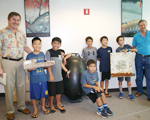 Jan Hafner has been busy helping student-groups prepare for the 2015 FIRST® LEGO League, which has the theme "TRASH TREKSM Challenge". His pictures and simulations let students understand how ocean debris moves through the gyres and collects in "garbage patches." He shows them real pieces that have drifted to Hawaii from the 2011 tsunami as well as other plastic debris of various shapes and sizes, including nearly invisible micro plastics.This all makes the students aware of the huge ocean debris problem. In the photo you see a group of 5th grade Punahou students with Hafner (right) and Nikolai Maximenko. Together with Kin Wang, Hafner held a similar session via Face Time with students at Holomua Elementary School.
Jan Hafner has been busy helping student-groups prepare for the 2015 FIRST® LEGO League, which has the theme "TRASH TREKSM Challenge". His pictures and simulations let students understand how ocean debris moves through the gyres and collects in "garbage patches." He shows them real pieces that have drifted to Hawaii from the 2011 tsunami as well as other plastic debris of various shapes and sizes, including nearly invisible micro plastics.This all makes the students aware of the huge ocean debris problem. In the photo you see a group of 5th grade Punahou students with Hafner (right) and Nikolai Maximenko. Together with Kin Wang, Hafner held a similar session via Face Time with students at Holomua Elementary School.
IPRC Scientists show Frequency of El Niño-generated Sea Level Extremes to Increase with Effects of Climate Change
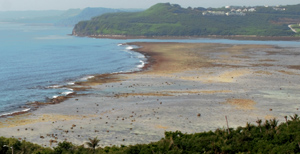
Honolulu, September 25, 2015
Gradual sea-level rise due to climate-induced melting of world-wide ice deposits is a well-known scenario at this stage, and many island nations in the tropical Pacific are already coping with the reality of an encroaching ocean. However, recent modeling research by IPRC scientists Matthew Widlansky and Axel Timmermann suggest that more frequent and extreme short-term sea level fluctuations may soon become an additional challenge. The new model incorporates the effects of a warming planet on the El Niño-La Niña phenomenon. The results show that intensified winds will double the frequency of the sea level fluctuations associated with these global weather patterns, particularly affecting the tropical southwestern Pacific. Read the press release for more details. Watch HawaiiNewsNow; and read Star-Advertiser, Climate Central, and Discovery News, and Hakai Magazine. Listen to Australian Broadcasting Station interview with Timmermann.
(Photo credit: Mark Lander, University of Guam)
IPRC Director Returns from Central Pacific after Collecting Data during Developing El Niño
Honolulu, August 19, 2015
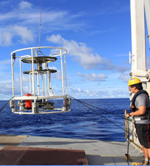 What happens to ocean mixing in the central equatorial Pacific during the developing phase of an El Niño ? This and other questions were at the forefront of IPRC Director Kelvin Richards' mind as he set out from Majuro in late July on the Research Vessel Falkor with a team of scientists from UH and Korea. The scientists collected data close to the equator and dateline on the flow structures that create turbulence and mixing. The team has returned to Honolulu onboard the vessel. Now we await the story that the analysis of these exciting measurements will tell about the causes of ocean mixing and its impact on the coupled ocean-atmosphere system. Read press release, and KITV 4 News, and Hawaii News Now and Radio Australia.
What happens to ocean mixing in the central equatorial Pacific during the developing phase of an El Niño ? This and other questions were at the forefront of IPRC Director Kelvin Richards' mind as he set out from Majuro in late July on the Research Vessel Falkor with a team of scientists from UH and Korea. The scientists collected data close to the equator and dateline on the flow structures that create turbulence and mixing. The team has returned to Honolulu onboard the vessel. Now we await the story that the analysis of these exciting measurements will tell about the causes of ocean mixing and its impact on the coupled ocean-atmosphere system. Read press release, and KITV 4 News, and Hawaii News Now and Radio Australia.
IPRC Marine Debris Drift Model Simulates MH370 Crash Site and Flow Paths
Honolulu, August 6, 2015
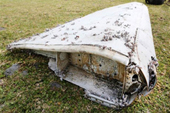 The IPRC Marine Debris Drift Model has simulated the flow paths of the flaperon from the likely crash site of Flight MH370 to Reunion and also maps to guide on-shore search for Flight MH370 Debris. The developers of this model, Nikolai Maximenko and Jan Hafner, have been using it to successfully simulate the pathways of millions of tons of marine debris from the 2011 tsunami in Japan. View the simulation and the maps.
The IPRC Marine Debris Drift Model has simulated the flow paths of the flaperon from the likely crash site of Flight MH370 to Reunion and also maps to guide on-shore search for Flight MH370 Debris. The developers of this model, Nikolai Maximenko and Jan Hafner, have been using it to successfully simulate the pathways of millions of tons of marine debris from the 2011 tsunami in Japan. View the simulation and the maps.
Axel Timmermann Elected AGU Fellow
Honolulu, July 28, 2015 
IPRC's Axel Timmermann has been elected an American Geophysical Union Fellow. "Being elected a Union Fellow is a tribute to those AGU members who have made exceptional contributions to Earth and space sciences as valued by their peers and vetted by section and focus group committees. This honor is bestowed on only 0.1% of the membership in any given year," according to the EOS announcement. Timmermann and his 2015 American Geophysical Union Class of Fellows will be recognized at an award ceremony, held during the 2015 Annual AGU Fall Meeting in San Francisco, California.
IPRC Director Leads Scientific Team in Ocean Turbulence Study
Honolulu, July 21, 2015
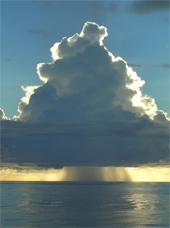 IPRC Director Kelvin Richards heads out to the central equatorial Pacific to lead a science team from the University of Hawai`i, Seoul National University, and the Korean Institute for Ocean Science and Technology. On board the R/V Falkor operated by the Schmidt Ocean Institute, the team will gather data on small-scale turbulence in the region. Though coupling between the tropical ocean and atmosphere is known to be very dependent on the mixing produced by ocean turbulence, little is known about the mechanisms producing the turbulence. The new data set, combined with data from Richard’s previous work in other tropical Pacific regions, will let scientists determine more clearly what controls the mixing by turbulence. Among other things, the work will help improve the representation of ocean turbulence in models used to understand and forecast El Niño Southern Oscillations events (ENSOs). The Schmidt Ocean Institute and NSF are funding the three-week expedition. Read more.
IPRC Director Kelvin Richards heads out to the central equatorial Pacific to lead a science team from the University of Hawai`i, Seoul National University, and the Korean Institute for Ocean Science and Technology. On board the R/V Falkor operated by the Schmidt Ocean Institute, the team will gather data on small-scale turbulence in the region. Though coupling between the tropical ocean and atmosphere is known to be very dependent on the mixing produced by ocean turbulence, little is known about the mechanisms producing the turbulence. The new data set, combined with data from Richard’s previous work in other tropical Pacific regions, will let scientists determine more clearly what controls the mixing by turbulence. Among other things, the work will help improve the representation of ocean turbulence in models used to understand and forecast El Niño Southern Oscillations events (ENSOs). The Schmidt Ocean Institute and NSF are funding the three-week expedition. Read more.
Former IPRC Scientist Wins Prestigious Prize in Japan
Honolulu, May 20, 2015
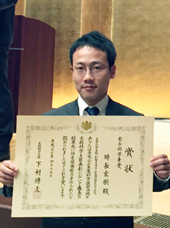 Hiroki Tokinaga, former IPRC assistant researcher and now associate professor at Kyoto University, received the Young Scientists' Prize of
"Commendations for Science and Technology" from the Japan Ministry of
Education, Culture, Sports, Science and Technology (MEXT). Each year MEXT
gives this award to scientists under the age of 40 for their outstanding
research and development capabilities in the field of science and
technology. Tokinaga was awarded this prestigious prize for his work on
"ocean-atmosphere interaction and its impact on climate formation and
variability." This work includes his many scientific achievements at the IPRC.
This year, 97 young researchers received the award during a
ceremony held on April 15, 2015 at MEXT in Tokyo.
Hiroki Tokinaga, former IPRC assistant researcher and now associate professor at Kyoto University, received the Young Scientists' Prize of
"Commendations for Science and Technology" from the Japan Ministry of
Education, Culture, Sports, Science and Technology (MEXT). Each year MEXT
gives this award to scientists under the age of 40 for their outstanding
research and development capabilities in the field of science and
technology. Tokinaga was awarded this prestigious prize for his work on
"ocean-atmosphere interaction and its impact on climate formation and
variability." This work includes his many scientific achievements at the IPRC.
This year, 97 young researchers received the award during a
ceremony held on April 15, 2015 at MEXT in Tokyo.
Highest Carbon Dioxide levels ever recorded!
Honolulu, May 12, 2015
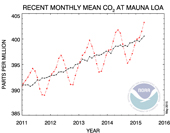 A recent NOAA report shows that the global mean carbon dioxide concentrations reached 400 parts per million in March - the highest level on record. IPRC's Axel Timmermann, interviewed by Beth-Ann Kozlovich on Hawaii Public Radio, talked about the implications of this new record. The last time CO2 concentrations were this high was 4 - 5 million years ago, when the Greenland and West Antarctic ice sheets did not exist and sea level was at least 30 ft. higher than today. He spoke about the accelerating rate of CO2 emissions, the difficulty of communicating the science to climate-change deniers, and the enormous behavioral changes needed to avoid reaching the 2C global mean temperature threshold for dangerous climate change within 20 to 50 years. Listen to interview.
A recent NOAA report shows that the global mean carbon dioxide concentrations reached 400 parts per million in March - the highest level on record. IPRC's Axel Timmermann, interviewed by Beth-Ann Kozlovich on Hawaii Public Radio, talked about the implications of this new record. The last time CO2 concentrations were this high was 4 - 5 million years ago, when the Greenland and West Antarctic ice sheets did not exist and sea level was at least 30 ft. higher than today. He spoke about the accelerating rate of CO2 emissions, the difficulty of communicating the science to climate-change deniers, and the enormous behavioral changes needed to avoid reaching the 2C global mean temperature threshold for dangerous climate change within 20 to 50 years. Listen to interview.
A strong El Niño in 2015?
Honolulu, May 11, 2015
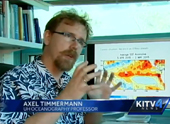 Compared to last year's ocean sea surface temperatures in the equatorial central-to-eastern Pacific, we are already in an El Niño state, says IPRC's Axel Timmermann in an interview with Cam Tran, KITV4 News. "It's very likely that we're going to have a strong El Niño in the next 3-4 months" with a relatively wet summer and dry winter in Hawaii. It could also mean a higher generation of storms in the central Pacific. Watch news clip. More recently, Timmermann was interviewed also by CBS San Francisco. Listen to podcast.
Compared to last year's ocean sea surface temperatures in the equatorial central-to-eastern Pacific, we are already in an El Niño state, says IPRC's Axel Timmermann in an interview with Cam Tran, KITV4 News. "It's very likely that we're going to have a strong El Niño in the next 3-4 months" with a relatively wet summer and dry winter in Hawaii. It could also mean a higher generation of storms in the central Pacific. Watch news clip. More recently, Timmermann was interviewed also by CBS San Francisco. Listen to podcast.
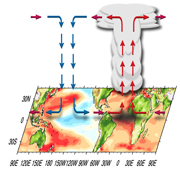
Extending climate predictability beyond El Niño
Honolulu, April 21, 2015
Tropical Pacific climate variations and their global weather impacts may be predicted much further in advance than previously thought, according to research by IPRC's Yoshimitsu Chikamoto and Axel Timmermann and their international colleagues in the USA, Australia, and Japan. The source of this predictability lies in the tight interactions between the ocean and the atmosphere and among the Atlantic, the Pacific and the Indian Oceans. Such long-term tropical climate forecasts are useful to the public and policy makers. Read more in Science Daily; and Phys.org; and Uma (in)certa antropologia; listen to Axel Timmermann's interview on HPR's Conversation
IPRC's Axel Timmermann wins UH Regents' Medal for Excellence in Research
Honolulu, April 16, 2015
 The University of Hawaii is awarding IPRC's Axel Timmermann the distinguished Regents' Medal for Excellence in Research for his outstanding accomplishments in climate science. He will receive the medal at an awards ceremony to be held May 5, 2015, from 4:00 to 5:00 pm, in Kennedy Theatre. The ceremony is preceded by a private reception in honor of Timmermann. The prize comes with a $1,000 monetary award. Furthermore, the Research Corporation of the University of Hawaii is honoring Timmermann and his achievements with a $5,000 research fund. Congratulations Axel!
The University of Hawaii is awarding IPRC's Axel Timmermann the distinguished Regents' Medal for Excellence in Research for his outstanding accomplishments in climate science. He will receive the medal at an awards ceremony to be held May 5, 2015, from 4:00 to 5:00 pm, in Kennedy Theatre. The ceremony is preceded by a private reception in honor of Timmermann. The prize comes with a $1,000 monetary award. Furthermore, the Research Corporation of the University of Hawaii is honoring Timmermann and his achievements with a $5,000 research fund. Congratulations Axel!
Japanese high school students visit IPRC
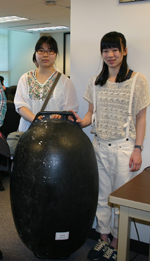
March 5, 2015
The International Pacific Research Center once again welcomed 21 Japanese high school students and their 3 teachers. They were from Morioka Daisan High School. The purpose of their trip to Hawaii was to be exposed to spoken English in an academic environment with a science focus.
Morioka, the capital of Iwate Prefecture, suffered much devastation in the March 2011 tsunami. The students thus listened attentively to the 90 minute powerpoint presentation by IPRC's Jan Hafner about the IPRC tsunami and marine debris model and how the model was able to track the travels of the debris across the ocean to the North Pacific Coast, and some of it into the Great Garbage Patch and then onto the north-east facing shores of Hawaii. Read more.
Bin Wang awarded the Gustaf-Rossby Research Medal

Phoenix, January 7, 2015
At the awards banquet of the 95th Annual meeting of the American Meteorological Society, IPRC's Bin Wang received the Carl-Gustaf Rossby Research Medal "for creative insights leading to important advances in the understanding of tropical and monsoonal processes and their predictability." This medal is the highest award for atmospheric science of the American Meteorological Society. PDF Announcement.
CONGRATULATIONS BIN!
2014, 2013, 2012, 2011, 2010, 2009, 2008, 2007, 2006, 2004, 2003, 2002, 2001, 2000

